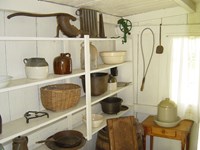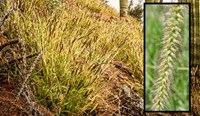- Lesson Plan (322)
- Student Activities (77)
- Distance Learning (73)
- Field Trips (65)
- Other Education Materials (21)
- Teacher Reference Materials (20)
- Traveling Trunk (17)
- Guest Speakers (12)
- Primary Sources (8)
- Teacher Workshops & Other Programs (3)
- Field Schools & Institutes (1)
- Media for Loan (1)
- Science Labs (1)
- Acadia National Park (30)
- Glacier National Park (20)
- Cowpens National Battlefield (13)
- Mount Rushmore National Memorial (12)
- Wrangell - St Elias National Park & Preserve (12)
- Carl Sandburg Home National Historic Site (11)
- Grant-Kohrs Ranch National Historic Site (11)
- Yellowstone National Park (11)
- Florissant Fossil Beds National Monument (10)
- Show More ...
- Social Studies (351)
- Science (260)
- Literacy and Language Arts (158)
- Math (68)
Showing 585 results for usgs ...
What Is That Used For?
Land Use
- Type: Lesson Plan
- Grade Levels: Middle School: Sixth Grade through Eighth Grade

In "Land Use," students discuss how people live and survive in their environments. The Homesteaders, Immigrants, and Native Americans unit is broken up into five lesson plans, taking 45-120 minutes to complete, targeting sixth through eighth grade students. A class does not have to complete every lesson in the unit - each lesson comes with its own set of objectives and resources. This is lesson 3 of the unit.
Daily Water Use
- Type: Student Activities
- Grade Levels: Upper Elementary: Third Grade through Fifth Grade
And introduction to how much water your students use everyday.
- Type: Lesson Plan
- Grade Levels: Middle School: Sixth Grade through Eighth Grade
A dichotomous key is an important scientific tool, used to identify different organisms, based the organism’s observable traits. Dichotomous keys consist of a series of statements with two choices in each step that will lead users to the correct identification.
Compass Use Adventure
- Type: Student Activities
- Grade Levels: Upper Elementary: Third Grade through Fifth Grade

Students will be able to navigate through at least 5 landmarks in the outdoor campus using the directional signals of a compass rose. The affective goal of this activity is to have the students get outside and navigate through their natural world. I want them to see the importance of using a compass instead of just understanding how to read NSEW on google maps.
Using the Film "Andersonville" in the Classroom
- Type: Teacher Reference Materials
- Grade Levels: High School: Ninth Grade through Twelfth Grade

Popular media, such as books and films, have long been used to teach the story of Andersonville. The 1996 film "Andersonville" continues to be a popular classroom tool. This material is intended to assist teachers in clearly identifying historical reality versus Hollywood illusion and aiding students to think critically about the portrayal of historic events.
Understanding Percent Using Buffelgrass
Compass Course - Using a Compass
Cultural Uses of Native Plants
- Type: Field Trips
- Grade Levels: Middle School: Sixth Grade through Eighth Grade
Hidatsa Tribe Use of Prairie Plants
- Type: Lesson Plan
- Grade Levels: Upper Elementary: Third Grade through Fifth Grade

Do your students need practice finding and utilizing information on a website? This lesson uses the Knife River Indian Villages NHS Park Stewards project on the nationally acclaimed iNaturalist website to accomplish this objective. Students will have fun exploring the site while learning how the Hidatsa and other Plains Indian tribes used the native prairie.
Pinning Up the Past: Using timelines
- Type: Field Trips
- Grade Levels: Middle School: Sixth Grade through Eighth Grade
Life as a Civil War Sailor in the US Navy
Calling Andrew Johnson using Morse Code
- Type: Lesson Plan
- Grade Levels: Middle School: Sixth Grade through Eighth Grade
The students will analyze the impact of the transatlantic telegraph on worldwide communications. The students will compare and contrast current technology to that of the 19th century.
Dueling Mandates: Preservation and Use of National Parks
- Type: Lesson Plan
- Grade Levels: Upper Elementary: Third Grade through Fifth Grade

Using dilemma cards describing some of the issues affecting Yellowstone National Park, students work in small groups to consider management issues that meet both of the conflicting mandates that the National Park Service must follow. After the investigation, students will be able to answer the question:
What about us??? Women, African-Americans, and Native Americans
- Type: Lesson Plan
- Grade Levels: Middle School: Sixth Grade through Eighth Grade
Students will research the roles of women, African-Americans and Native Americans in the American Revolution.
Sustainable Design Solutions: Mitigating Effects of Natural Resource Use
Those Who Walked Before Us: American Indians of the Natchez Trace
- Type: Distance Learning ... Field Trips
- Grade Levels: Middle School: Sixth Grade through Eighth Grade
George Washington Carver - An Original Conservationist: Alternative Uses for Everyday Materials
- Type: Lesson Plan
- Grade Levels: High School: Ninth Grade through Twelfth Grade

This topic is a focus on alternative uses for source materials and products that can be made with alternative materials. Students will make peanut milk in an effort to understand how foods can be used in different ways to increase nutrition to the consumer. Students will create a pros/cons poster researching products (such as fuel) and comparing traditional source materials (crude oil) with alternative materials (corn or soy-based ethanol).









